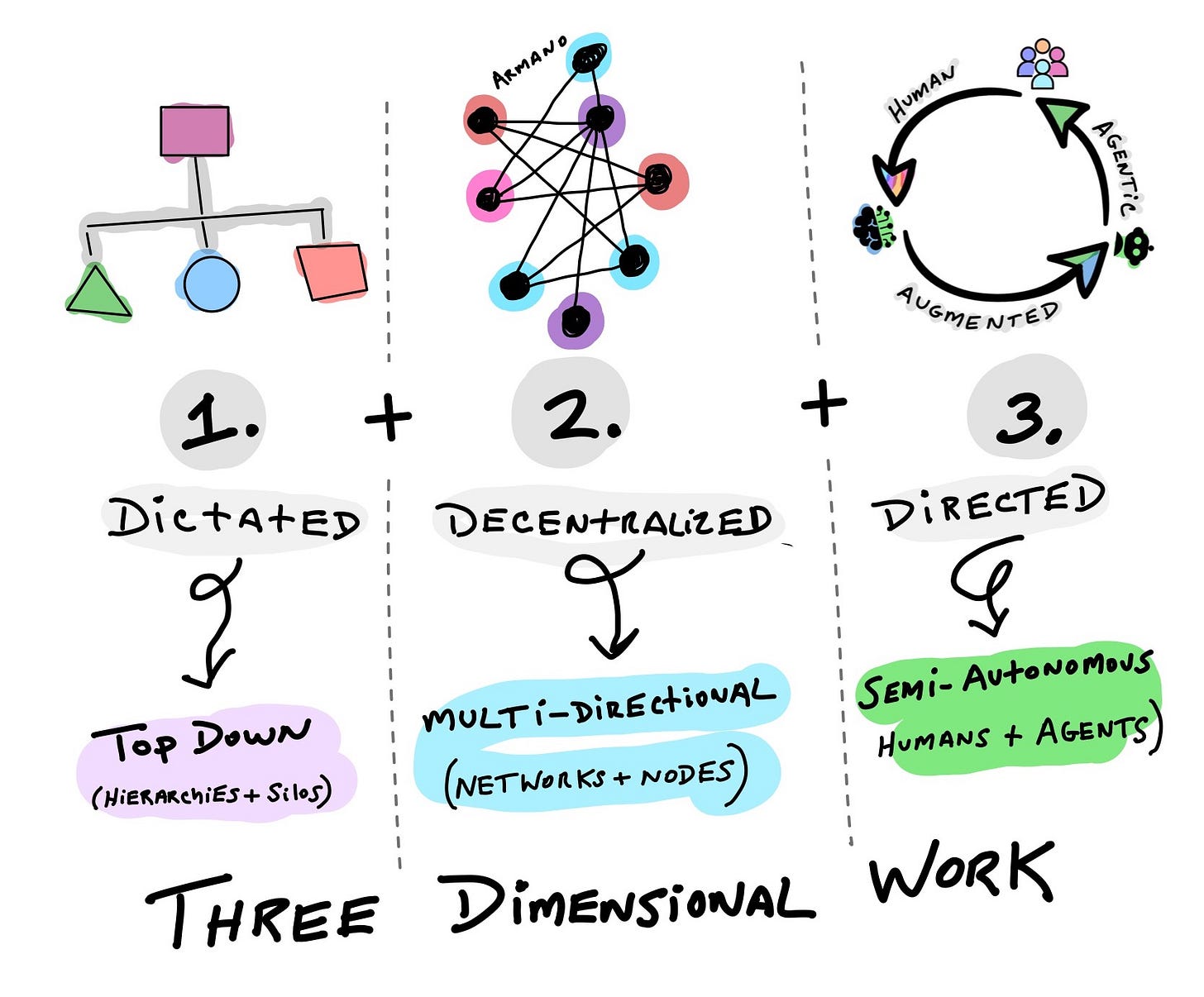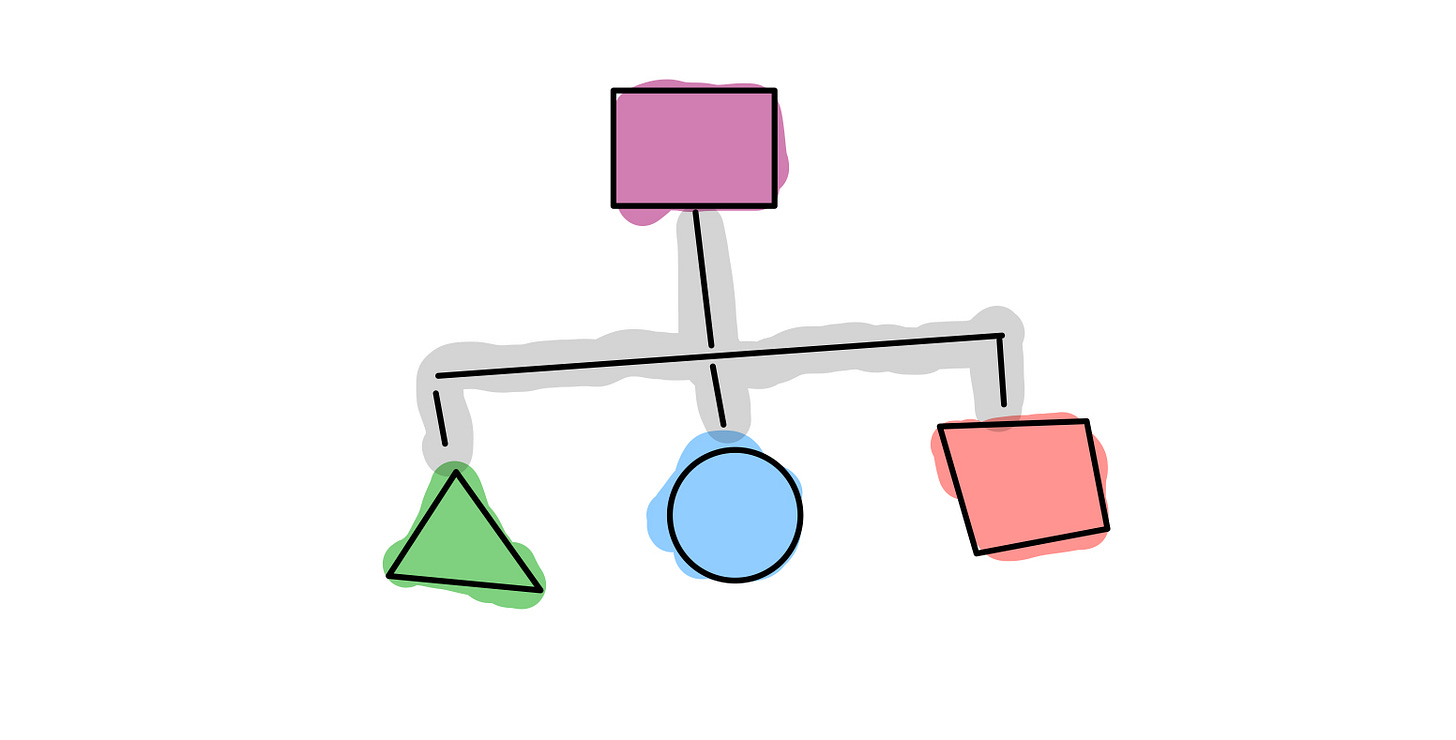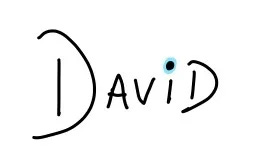The Three Dimensional Workforce
AI Assistants, Agents Add A New Dimension To How We Work
I landed my first corporate job opportunity by responding to a posting pinned to the physical job board in the career center at my alma mater, Pratt. In addition to doing an internship working on community television graphics in Brooklyn, I labored my way through college as a bar-back (IYKYK). I could barely contain my excitement when I got that first desk job right after graduation. I was on top of the world and thrilled at the prospect of making a living that wouldn’t have me coming home at 4:30 AM smelling like ZIMA (also, IYKYK). Looking back, my first career job feels familiar in some ways and yet utterly foreign in others. I worked in a midtown Manhattan skyscraper overlooking Rockefeller Center. I had my own desk, shared an office space with a colleague, and had a dedicated phone line, among other traditional corporate amenities.
I worked in the “graphics department,” and my boss reported to the head of that department. Departmental meetings were held in person, and aside from working with our copywriting peers, we were isolated from other parts of the company. There was no Slack, no Zoom, no mobile phones or social media, no apps, and no AI. I did have email, but in those days, it was used very sparingly, unlike in the years to come, when email and knowledge work would become synonymous and interdependent.
New Ways Of Working Are Built On The Old
When I reflect on that first job, I realize that after spending thirty years in the corporate workforce, change actually happens very gradually. But it does happen, and over those thirty years, the way I (and we) now work is something of a paradox. In some ways, it’s similar, while in other ways, it’s different. The common myth of workplace transformation is that the old ways of working disappear. Some of them do, but others remain in place, and we build upon them as they coexist and evolve. Case in point, you probably still use email for work, right?
Right.
1. Hierarchy, Then And Now
First, let’s call out the obvious: traditional hierarchy is going nowhere and neither are BUs or those operational silos that organizational design consultancies love to reimagine. What is changing is that corporate culture has evolved to be more informal and it feels a little less structured. However, if you work in an organization, you will have a boss, your boss will have a boss, and you will be part of the business function you report into. Yes, many organizations have “flattened” (a concept highly relevant today), but they still have reporting structures and chains of command. Some other changes over the past thirty years have been in the office spaces themselves. Of course, now, in the post-pandemic world of work, we have open workspaces with less obvious office hierarchy reflected in the spaces themselves, and then there’s also more remote work. But essentially, corporate organizational structures will continue to be built on some form of hierarchical foundation.
Get used to it.
2. Multi-Directional Work
As mentioned earlier, our dependence on email continued, and it eventually pushed the technology's boundaries beyond its intended use. Still, to this day, email remains the primary foundation for how work gets done. But technology continued to advance, and the enterprise technology sector drew heavily from consumer applications being developed during the social-mobile Web era. And so, platforms like Slack, Teams, Google Docs, Confluence, etc. became part of the work ecosystem. These systems allow for multidirectional work, enabling fluid collaboration from multiple time zones and geographies asynchronously. But things didn’t slow down after the Social-mobile era, when the pandemic hit, the Zoomification of work became as influential as email itself.
This multi-directional approach to working is how we’ve been managing work and peaked during the pandemic, but it doesn’t end here.
3. Human, Augmented, and Agentic: The Semi-Autonomous Work Loop
While we are still adapting to Zoom fatigue and toggling between the office and home office, we now have AI entering the workforce in two distinct shapes/forms:
AI-Augmented Work:
This is the work we produce with “models,” “LLMs,” assistants, or whatever flavor of the month we want to label them as. If you’re using Co-Pilot on the job or ChatGPT for personal use, you understand how this changes the game of knowledge work. I can’t and won’t go into that level of detail here, but I am intentionally using the label “AI-Augmented” because it best describes the output and work product. It is part AI, part human, and all augmented through human-machine collaboration and cooperation. It is through our interactions with these models—big or small, for personal or business use —that we work differently. This is the case today, even though it hasn’t become widespread in every organization (yet).
AI augments how we work.
Agentic Automation:
This is what the tech sector is all abuzz about. We’re at peak hype cycle for all things agents, “agentic” or agent-like. These are not LLMs, though they could be working in coordination with them, as well as with “human-in-the-loop” guidance or intervention. No, agents, by the nature of how they are currently being engineered, are autonomous by design, built to handle tasks and workflows while navigating singular or multiple systems. Their crude predecessors were “bots”, not unlike the predecessor of LLMs, was “dumb” Conversational AI (think Siri or Alexa before the GenAI days). Agents and Agentic systems are the ghosts in the machine, and more importantly, they will be the closest thing that knowledge workers will face, which compares to modern robotics on industrial assembly lines. My NTT Data colleague, Nate Spillson, recently penned a thoughtful piece on agentic systems, challenging readers to unlearn linear processes, and he accurately underscores that working with agentic systems is going to test our boundaries, ultimately around trusting these emerging autonomous technologies:
Striking the balance between access, oversight, autonomy and trust is our next challenge. One potential solution is local model execution to help address security and privacy concerns. Just as we’ve learned to manage human trust in workplaces, we’ll get better at distinguishing reliable AI models and use them safely. As these systems become more capable, norms around access and trust will evolve, powered by, you guessed it, models and agents.
It is this intricate relationship between human-generated, AI-augmented, and agentic automation working in semi-autonomous loops that will, in time, become how we humans and machines work together. How much we build trust in this semi-autonomous work loop will depend on the quality and reliability of our combined human- and machine-generated output.
Dictated, Decentralized, Directed: The Three-Dimensional Workforce
All of these dynamics combined result in what I like to think of as the three-dimensional workforce. It is the old world meeting the new and reconciling the things that won’t change (like traditional hierarchies, silos and org charts), with the inevitable newer ways of working powered by AI. Yes, there will be some “AI-first” companies that move fast, creating entirely new business models that leverage many of the AI-dependent advances I outline here. But some of those organizations will scale, which means more humans, which means more three-dimensional work. It’s also true that companies can and will become leaner, just like modern assembly lines rely on fewer human workers compared to decades ago. But even modern assembly lines still need humans. I often retell the story of how Elon Musk over-automated his assembly line during Tesla's early, critical days. In true engineering fashion, he identified the problems in the line, removed or recalibrated the things slowing it down (many issues were related to the automated aspects). Then he rebuilt the system, ultimately getting it right and hitting his aggressive goals. We’ll see a lot of this happen in the three-dimensional workforce as it becomes both AI-augmented and agent-automated over time.
In summary, we can expect some parts of our three-dimensional work to feel “dictated,” like doing annual reviews or following a directive from our boss. Work will still occur on platforms like Slack and Teams, both asynchronously and in a decentralized manner. I can guarantee that we will still have email accounts and probably even check them occasionally. But more of our work will be done in partnership with AI, and some tasks, workflows, and systems will operate independently, with focused human oversight. I like to use the word “directed” in this context, as we humans should be directing the AI, even when the agents are working independently of us.
So here’s to doing AI-augmented and Agentic business, in 3D.
Visually yours,







Fully agree, as I also think that this is an essential truth: the future of work is not about replacing humans but about complementing human strengths.
Your picture of the three-dimensional work resonates a lot. Finding the right balance between established structures, decentralized collaboration, and the responsible use of AI will be key to making real progress.
David - thank you. I think this is a great framework to look organizational change. As I read this, I couldn't help but think about new civilizations are routinely built on top of the prior (new job: organizational archaeologist?) The job effectively stays the same, or the desired outcomes remain, the tools used are what changes.
My first corporate job nearly 40 years ago as a "Draftsman" was in the old-school open-air office, with drafting tables lining the walls and we all shared a two-line, party-line phone system. Voice mail? That was the guy at the desk behind me. This was the early days of Computer Aided Design becoming popular (e.g. affordable) outside aerospace and automotive. I really owe a big part of my early career to being part of that digital transformation. It was more evolution than revolution, but I can certainly remember a time well before even e-mail - inter-departmental envelopes with typed memos and requests for meetings.
I make sure to embrace these changes as I had many colleagues early on who thought it was all a fad. It isn't. Even if the current generation of AI/ LLMs etc. do not stay in their current form (they won't) the impact of the change will remain.